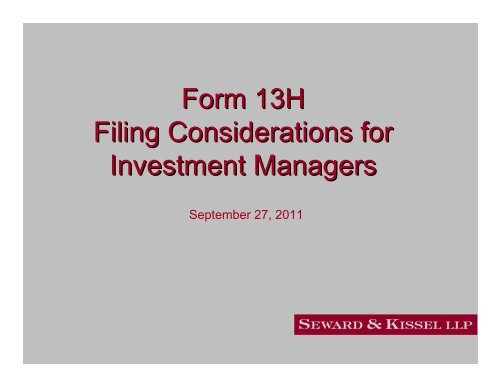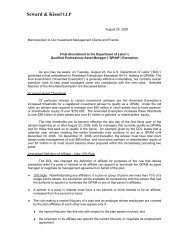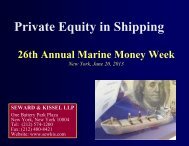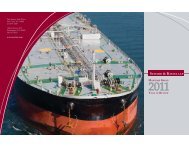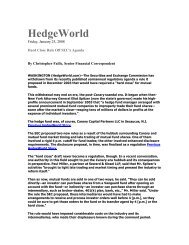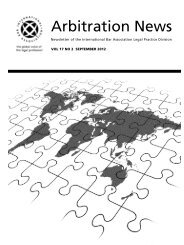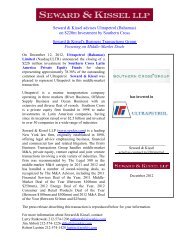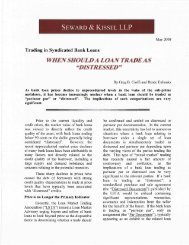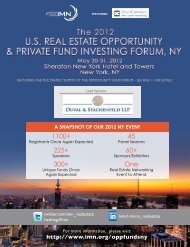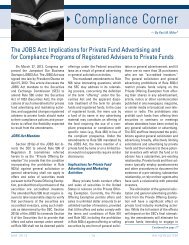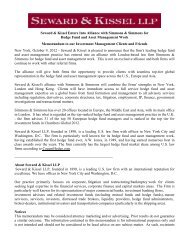Form 13H - Seward and Kissel
Form 13H - Seward and Kissel
Form 13H - Seward and Kissel
You also want an ePaper? Increase the reach of your titles
YUMPU automatically turns print PDFs into web optimized ePapers that Google loves.
<strong>Form</strong> <strong>13H</strong><br />
Filing Considerations for<br />
Investment Managers<br />
September 27, 2011
Table of Contents<br />
I.<br />
II.<br />
III.<br />
IV.<br />
V.<br />
VI.<br />
VII.<br />
VIII.<br />
IX.<br />
X.<br />
Introduction ...........................................................................................................................................................<br />
Background ...........................................................................................................................................................<br />
Who is a Larger Trader? …………………………………………………………………………………….<br />
Who has the filing obligation? ……………………………………………………………………………..<br />
Calculating the Identifying Activity Level .................................................................................................<br />
Confidentiality ……………………………………………………………………………………….................<br />
Timing of <strong>Form</strong> <strong>13H</strong> filing requirements.............................................................................<br />
Overview of <strong>Form</strong> <strong>13H</strong> ......................................................................................................<br />
Questions ..........................................................................................................................<br />
Speaker biographies .......................................................................................................<br />
3<br />
7<br />
12<br />
16<br />
20<br />
26<br />
29<br />
37<br />
47<br />
48<br />
2
I. Introduction<br />
3
Introduction<br />
• Who files <strong>Form</strong> <strong>13H</strong>?<br />
– Any person that directly or indirectly exercises investment discretion<br />
over transactions in listed US equity securities <strong>and</strong> listed options in an<br />
aggregate amount equal to or greater than the Identifying Activity Level.<br />
• What is the Identifying Activity Level?<br />
– during a calendar day, either two million shares or shares with a fair<br />
market value of $20 million; or<br />
– during a calendar month, either twenty million shares or shares with a<br />
fair market value of $200 million.<br />
4
Introduction<br />
• What is reported?<br />
– Information related to a Large Trader’s business, affiliates, other SEC<br />
filings, regulatory status, organizational structure <strong>and</strong> the names of the<br />
broker-dealers where a Large Trader <strong>and</strong> certain of its affiliates have<br />
accounts<br />
• When must a Large Trader file?<br />
– Promptly after first effecting aggregate transactions equal to or greater<br />
than the Identifying Activity level <strong>and</strong> annually thereafter. The Rule is<br />
effective October 3, 2011, entities that meet the Large Trader definition<br />
after that date must file <strong>Form</strong> <strong>13H</strong> by December 1, 2011.<br />
5
Introduction<br />
• How does a Large Trader file <strong>Form</strong> <strong>13H</strong>?<br />
– With the SEC.<br />
– Electronically on EDGAR.<br />
• Link to <strong>Form</strong> <strong>13H</strong> <strong>and</strong> Adopting Release:<br />
– http://www.sec.gov/rules/final/2011/34-64976fr.pdf<br />
6
II. Background<br />
7
Background<br />
• Section 13(h) of the Securities Exchange Act of 1934 was adopted in 1990<br />
as part of the Market Reform Act of 1990.<br />
• Section 13(h) established a large trader reporting system in accordance<br />
with regulations to be adopted by the SEC.<br />
• In 1991 <strong>and</strong> 1994, the SEC proposed but never adopted reporting<br />
requirements.<br />
8
What is the purpose of <strong>Form</strong> <strong>13H</strong>?<br />
• The SEC Adopting Release indicates that <strong>Form</strong> <strong>13H</strong> is intended to :<br />
– serve as a source of data for SEC investigative <strong>and</strong> enforcement action;<br />
– facilitate the SEC’s ability to assess the impact of Large Trader activity<br />
on markets; <strong>and</strong><br />
– help the SEC reconstruct trading activity after unusual market volatility<br />
(such as the events of May 6, 2010).<br />
9
Large Trader reporting obligations<br />
• Large Traders must register with the SEC by filing <strong>Form</strong> <strong>13H</strong> electronically<br />
through EDGAR.<br />
• The SEC will assign each filing Large Trader a Large Trader identification<br />
number (an “LTID”).<br />
• Each Large Trader must disclose its LTID to all registered broker-dealers<br />
effecting transactions on its behalf.<br />
10
Rule 13h-1 broker-dealer obligations<br />
• Rule 13h-1 requires registered broker-dealers to:<br />
– maintain certain information <strong>and</strong> records with respect to transactions<br />
effected by or through an account carried by the broker-dealer for a<br />
Large Trader; <strong>and</strong><br />
– provide such information <strong>and</strong> records to the SEC upon its request.<br />
11
III. Who is a Large Trader?<br />
12
Definition of a Large Trader<br />
• A “Large Trader” is any person that, directly or indirectly, including through<br />
other persons controlled by such person, exercises investment discretion<br />
over transactions in NMS securities, by or through one or more registered<br />
broker-dealers, in an aggregate amount equal to or greater than the<br />
Identifying Activity Level.<br />
• Large Trader filing obligations apply to all U.S. <strong>and</strong> non-U.S. persons that<br />
meet the definition.<br />
• To the extent that an entity employs a natural person who individually meets<br />
the definition of a Large Trader, the entity that controls that person would be<br />
a Large Trader (i.e., an entity’s employees who exercise investment<br />
discretion within the scope of their employment are deemed to be doing so<br />
on behalf of the entity).<br />
13
Investment discretion<br />
• For purposes of the Large Trader determination, a person is deemed to<br />
exercise “investment discretion” with respect to an account if, directly or<br />
indirectly, such person:<br />
– is authorized to determine what securities or other property shall be<br />
purchased or sold by or for the account;<br />
– makes decisions as to what securities or other property shall be<br />
purchased or sold by or for the account even though some other person<br />
may have responsibility for such investment decisions; or<br />
– otherwise exercises such influence with respect to the purchase <strong>and</strong><br />
sale of securities or other property by or for the account as the SEC, by<br />
rule, determines, in the public interest or for the protection of investors,<br />
should be subject to the operation of the provisions of the Securities<br />
Exchange Act of 1934 <strong>and</strong> the rules <strong>and</strong> regulations thereunder.<br />
14
What types of entities may qualify as Large<br />
Traders?<br />
• Investment advisers (whether or not registered) to private funds <strong>and</strong>/or<br />
registered funds<br />
• Broker-dealers<br />
• Futures Commission Merchants<br />
• Commodity Pool Operators<br />
• Bank Holding Companies<br />
• Non-Bank Holding Companies<br />
• Banks<br />
• Pension Trustees<br />
• Non-Pension Trustees<br />
• Insurance Companies<br />
15
IV. Who has the filing obligation?<br />
16
Parent Company Level Registration<br />
• <strong>Form</strong> <strong>13H</strong> filing obligations are imposed on the ultimate parent<br />
company of an entity (or entities under common control) which meets<br />
the definition of a Large Trader.<br />
• To determine whether a parent company is a Large Trader, the<br />
trading activity of all entities controlled by the parent company must<br />
be aggregated.<br />
• If the aggregate amount <strong>and</strong>/or value of the trading activity of such<br />
entities equals or exceeds the Identifying Activity Level, the parent<br />
company will have a <strong>Form</strong> <strong>13H</strong> filing obligation (unless all of its<br />
affiliates comply on its behalf).<br />
17
Definition of “Control”<br />
for purposes of determining whether a parent<br />
company is a Large Trader<br />
• For purposes of the Rule, control means the power to direct or cause the<br />
direction of the management <strong>and</strong> policies of a person, whether through the<br />
ownership of securities, by contract, or otherwise.<br />
– For an entity, a person has control when it directly or indirectly has the<br />
right to vote or direct the vote of 25% or more of a class of voting<br />
securities of an entity or has the power to sell or direct the sale of 25%<br />
of more of a class of voting securities of such entity.<br />
– For a partnership, a person has control if it has the right to receive, upon<br />
dissolution, or has contributed, 25% of more of the capital of the<br />
partnership.<br />
18
Determining the ultimate parent company for<br />
private fund managers<br />
• A typical private fund manager entity which acts as the investment<br />
adviser for one or more pooled investment vehicles (or separately<br />
managed accounts) will have the <strong>Form</strong> <strong>13H</strong> filing obligation.<br />
• In the event that a private fund manager with a <strong>Form</strong> <strong>13H</strong> filing<br />
obligation is controlled by an entity, the filing obligation may be<br />
pushed up to the entity that controls the private fund manager.<br />
• Where both U.S. <strong>and</strong> non-U.S. pooled investment vehicles are<br />
advised by an investment manager <strong>and</strong> a general partner under<br />
common control, the investment manager entity will typically have<br />
the <strong>Form</strong> <strong>13H</strong> filing obligation, because it exercises investment<br />
discretion over the investment vehicles.<br />
19
V. Calculating the Identifying Activity<br />
Level<br />
20
What is the “Identifying Activity Level”?<br />
• The Identifying Activity Level is triggered if aggregate transactions in NMS<br />
securities are equal to or greater than the Daily or Monthly Threshold:<br />
– Daily Threshold: during a calendar day, either two million shares or<br />
shares with a fair market value of $20 million; or<br />
– Monthly Threshold: during a calendar month, either twenty million<br />
shares or shares with a fair market value of $200 million.<br />
21
NMS securities<br />
• NMS securities are any securities or class of securities for which transaction<br />
reports are collected, processed, <strong>and</strong> made available pursuant to an<br />
effective transaction reporting plan, or an effective national market system<br />
plan for reporting transactions in listed options.<br />
• NMS securities refer generally to U.S. exchange-listed securities, including<br />
equities <strong>and</strong> options.<br />
• A list of NMS securities will not be available.<br />
22
Treatment of options for purposes of<br />
calculating the Identifying Activity Level<br />
• For purposes of calculating the Identifying Activity Level, the volume <strong>and</strong><br />
value of options purchased or sold would be determined by reference to the<br />
securities underlying the option.<br />
• For example, 50,000 shares of XYZ stock <strong>and</strong> 500 XYZ call options (to buy<br />
100 shares per option) would count as aggregate transactions of 100,000<br />
shares in XYZ (i.e., 50,000 + 500 x 100 = 100,000).<br />
23
Excluded transactions<br />
• The Rule includes specified excluded transactions which are not typically<br />
effected by an arm’s length purchase or sale. For purposes of calculating<br />
the Identifying Activity Level, the following transactions are excluded:<br />
– any journal or bookkeeping entry made to an account to record or<br />
memorialize the receipt or delivery of funds or securities pursuant to the<br />
settlement of a transaction;<br />
– any transaction that is part of an offering of securities by or on behalf of<br />
an issuer, or by an underwriter on behalf of an issuer, or an agent for<br />
an issuer, whether or not such offering is subject to registration under<br />
the Securities Act of 1933, provided, however, that this exemption shall<br />
not include an offering of securities effected through the facilities of a<br />
national securities exchange;<br />
24
Excluded transactions continued<br />
– any transaction that constitutes a gift;<br />
– any transaction effected by a court-appointed executor, administrator,<br />
or fiduciary pursuant to the distribution of a decedent’s estate;<br />
– any transaction effected pursuant to a court order or judgment;<br />
– any transaction effected pursuant to a rollover of qualified plan or trust<br />
assets subject to Section 402(c)(1) of the Internal Revenue Code; <strong>and</strong><br />
– any transaction between an employer <strong>and</strong> its employees effected<br />
pursuant to the award, allocation, sale, grant or exercise of a NMS<br />
security, option or other right to acquire securities at a pre-established<br />
price pursuant to a plan which is primarily for the purpose of an issuer<br />
benefit plan or compensatory arrangement.<br />
25
VI. Confidentiality<br />
26
Confidentiality<br />
• Information that a Large Trader will be required to disclose on <strong>Form</strong> <strong>13H</strong> or<br />
provide in response to a SEC request will be exempt from disclosure under<br />
the Freedom of Information Act (“FOIA”).<br />
• Any transaction data that a registered broker-dealer reports to the SEC<br />
under the Rule is also exempt from disclosure under FOIA.<br />
27
Confidentiality continued<br />
• The <strong>Form</strong> <strong>13H</strong> Adopting Release states that the SEC is committed to<br />
maintaining the information collected pursuant to the Rule in a manner<br />
consistent with Section 13(h)(7) of the Securities Exchange Act of 1934.<br />
• Section 13(h) specifies that the SEC shall not be compelled to disclose<br />
information collected from Large Traders <strong>and</strong> registered broker-dealers<br />
under a Large Trader reporting system, subject to limited exceptions.<br />
• Specifically, the statute provides that the SEC is not authorized to withhold<br />
information:<br />
– from Congress <strong>and</strong> other federal departments or agencies acting within<br />
the scope of their jurisdictions; <strong>and</strong><br />
– in connection with an order of a court of the United States in an action<br />
brought by the United States or the SEC.<br />
28
VII. Timing of <strong>Form</strong> <strong>13H</strong> filing<br />
requirements<br />
29
Transition/initial filing requirements<br />
for Large Traders<br />
• By December 1, 2011, entities meeting the definition of Large Trader after<br />
October 3, 2011 (the effective date of the Rule) must:<br />
– make the initial SEC filing to be assigned a LTID; <strong>and</strong><br />
– disclose the LTID to registered broker-dealers effecting transactions on<br />
their behalf.<br />
• Entities meeting the definition of Large Trader after December 1, 2011<br />
must file an initial <strong>Form</strong> <strong>13H</strong> with the SEC promptly after first effecting<br />
aggregate transactions equal to or greater than the Identifying Activity<br />
Level.<br />
30
Voluntary registration<br />
• An entity (or individual) may voluntarily register as a Large Trader by filing<br />
<strong>Form</strong> <strong>13H</strong> with the SEC.<br />
• A Large Trader must indicate on its initial <strong>Form</strong> <strong>13H</strong> filing whether it has<br />
chosen to voluntarily register.<br />
• A voluntary filer will be treated as a Large Trader for purposes of the Rule<br />
<strong>and</strong> will be subject to all of the obligations of a Large Trader under the Rule<br />
at the time it registers as a Large Trader.<br />
31
Transition/initial filing requirements<br />
for broker-dealers<br />
• Broker-dealers must comply with the requirements to maintain records,<br />
report transaction data when requested, <strong>and</strong> monitor Large Trader activity<br />
by April 30, 2012.<br />
32
Annual filing requirement<br />
• After the initial <strong>Form</strong> <strong>13H</strong> all filing Large Traders must file <strong>Form</strong> <strong>13H</strong><br />
annually with the SEC within 45 days after the end of each full calendar<br />
year.<br />
33
Amended Filing Requirement<br />
• An amendment must be filed immediately if any information contained in a<br />
filed <strong>Form</strong> <strong>13H</strong> becomes inaccurate.<br />
– For example, when a Large Trader adds a broker-dealer, it must amend<br />
its <strong>Form</strong> <strong>13H</strong> to reflect the additional broker-dealer in Item 6.<br />
• <strong>Form</strong> <strong>13H</strong> amendments must be filed no later than the end of the calendar<br />
quarter in which such information becomes inaccurate.<br />
34
Inactive Status<br />
• A Large Trader who has previously filed a <strong>Form</strong> <strong>13H</strong> may file for “inactive<br />
status” on its annual <strong>Form</strong> <strong>13H</strong> filing so long as it:<br />
– has not effected aggregate transactions at any time during the previous<br />
calendar year in an amount equal to or greater than the Identifying<br />
Activity Level.<br />
• During inactive status, a Large Trader:<br />
– is relieved of additional filing obligations; <strong>and</strong><br />
– may request that its broker-dealers cease tagging its transactions with<br />
its LTID.<br />
• Promptly after effecting transactions in an amount that equals or exceeds<br />
the Identifying Activity Level, an inactive Large Trader must reactivate its<br />
Large Trader status by filing a <strong>Form</strong> <strong>13H</strong>.<br />
35
Termination Filings<br />
• In limited circumstances, a Large Trader may terminate its Large Trader<br />
reporting status by filing a “Termination Filing” on <strong>Form</strong> <strong>13H</strong>.<br />
• A Large Trader should file a Termination Filing in order to indicate that it<br />
does not expect to file future <strong>Form</strong> <strong>13H</strong> filings, such as under circumstances<br />
where a Large Trader is dissolving, ceasing to do business, or being<br />
acquired.<br />
36
VIII. Overview of <strong>Form</strong> <strong>13H</strong><br />
37
Summary of information that must be<br />
disclosed on <strong>Form</strong> <strong>13H</strong><br />
• <strong>Form</strong> <strong>13H</strong> will require disclosure of:<br />
– contact persons<br />
– the business of the Large Trader<br />
– certain affiliates <strong>and</strong> governance<br />
– other SEC filings<br />
– regulatory status<br />
– organizational structure<br />
– the names of the broker-dealers where the Large Trader <strong>and</strong><br />
certain of its affiliates have accounts<br />
38
<strong>Form</strong> <strong>13H</strong> – Background Information<br />
• A Large Trader must provide contact information about the Large Trader<br />
<strong>and</strong> its Authorized Person<br />
• A Large Trader’s “Authorized Person” is the natural person authorized to<br />
submit the <strong>Form</strong> <strong>13H</strong> <strong>and</strong> make the certification on behalf of the Large<br />
Trader.<br />
39
<strong>Form</strong> <strong>13H</strong> – Item 1: Business of the Large<br />
Trader<br />
• A Large Trader must indicate the businesses that are engaged in by the<br />
Large Trader <strong>and</strong> its “affiliates”.<br />
– An affiliate is any person that directly or indirectly controls, is under<br />
common control with, or is controlled by the Large Trader.<br />
– The term "person" means a natural person, company, government, or<br />
political subdivision, agency, or instrumentality of a government.<br />
40
<strong>Form</strong> <strong>13H</strong> – Item 1: Business of the Large<br />
Trader continued<br />
• In addition, a Large Trader must provide a short description of its<br />
businesses <strong>and</strong> of the business of any of its affiliates that exercise<br />
investment discretion over NMS securities (each, a “Securities Affiliate”).<br />
– For example, an investment adviser Large Trader may describe its<br />
business by stating: “Investment adviser specializing in fundamental<br />
analysis,” <strong>and</strong> a broker-dealer Large Trader may describe its business<br />
by disclosing it is “An options market maker”.<br />
41
<strong>Form</strong> <strong>13H</strong> – Item 2: Securities <strong>and</strong> Exchange<br />
Commission Filings<br />
• A Large Trader must indicate whether it, or any of its Securities Affiliates,<br />
files any other forms with the SEC (e.g., a <strong>Form</strong> 13F filing).<br />
• If the Large Trader <strong>and</strong>/or its Securities Affiliates make SEC filings, the<br />
Large Trader must identify all:<br />
– filing entities;<br />
– forms filed; <strong>and</strong><br />
– CIK numbers<br />
42
<strong>Form</strong> <strong>13H</strong> – Item 3: CFTC Registration <strong>and</strong><br />
Foreign Regulators<br />
• A Large Trader must disclose whether it or any of its affiliates is registered<br />
with the Commodity Futures Trading Commission (“CFTC”) or regulated by<br />
a foreign regulator.<br />
• If so, the Large Trader must identify each such entity <strong>and</strong> its corresponding<br />
CTFC registration number or primary foreign regulator, as applicable.<br />
43
<strong>Form</strong> <strong>13H</strong> – Item 4: Organizational Information<br />
• This Item is intended to assist the SEC in underst<strong>and</strong>ing the affiliate<br />
structure of a Large Trader.<br />
• In Item 4(a), a Large Trader must attach an organizational chart which<br />
depicts the Large Trader, its parent company (if applicable), all of its<br />
Securities Affiliates, <strong>and</strong> any of the Large Trader’s affiliates that are<br />
registered with the CFTC <strong>and</strong> identified in Item 3(a).<br />
• In Item 4(b), a Large Trader must provide a narrative description of the<br />
relationships between all of the entities <strong>and</strong> persons depicted in the<br />
organizational chart.<br />
44
<strong>Form</strong> <strong>13H</strong> – Item 5: Governance of the Large<br />
Trader<br />
• A Large Trader must indicate whether it is an: individual, partnership, limited<br />
liability partnership, limited partnership, corporation, trustee or limited<br />
liability company.<br />
– If it is a partnership, it must identify each general partner <strong>and</strong> each<br />
limited partner that holds more than a 10% interest in its accounts.<br />
– If it is a corporation or a trustee, it must identify each executive officer,<br />
director or trustee.<br />
• A Large Trader must also disclose the jurisdiction in which it is incorporated<br />
or organized.<br />
45
<strong>Form</strong> <strong>13H</strong> – Item 6: List of Broker-Dealers at<br />
which the Large Trader or its Securities<br />
Affiliates has an Account<br />
• A Large Trader must identify all of the broker-dealers at which it, or any of<br />
its Securities Affiliates, has an account.<br />
• In addition, it must disclose whether each such broker-dealer provides<br />
prime broker, executing broker, <strong>and</strong>/or clearing broker services.<br />
46
IX. Questions?<br />
47
X. Speaker Biographies<br />
48
John E. Tavss<br />
John E. Tavss is the head of <strong>Seward</strong> & <strong>Kissel</strong>'s Investment Management Group.<br />
John has practiced at the Firm since 1979, <strong>and</strong> has been a partner since 1988.<br />
John advises clients on a wide variety of securities, tax <strong>and</strong> business law matters<br />
relating to the investment management business. John has significant expertise in<br />
the investment management area including the representation of "hedge funds," other<br />
private investment vehicles (both onshore <strong>and</strong> offshore) <strong>and</strong> private equity funds.<br />
John is a frequent speaker on "hedge fund" <strong>and</strong> other private investment fund issues.<br />
John is a member of the New York State Bar Association (Tax Section) <strong>and</strong> the<br />
International Bar Association (Private Funds Section). John is actively involved with a<br />
not-for-profit organization supported by the hedge fund industry dedicated to the<br />
prevention <strong>and</strong> treatment of child abuse.<br />
John has been regularly recognized in Chambers Global, Chambers USA <strong>and</strong> The<br />
International Who’s Who of Business Lawyers as a leading fund formation lawyer for<br />
private investment funds.<br />
John can be reached at (212) 574-1261 or tavss@sewkis.com.<br />
49
Steven B. Nadel<br />
Steven B. Nadel is a partner in <strong>Seward</strong> & <strong>Kissel</strong>’s Investment Management Group. He<br />
joined the Firm in 1997. He is also the founding editor of The Private Funds Report, the<br />
Group newsletter.<br />
Steve has extensive experience in issues relating to the establishment <strong>and</strong> ongoing<br />
operation of hedge funds, funds of funds (U.S. <strong>and</strong> offshore), private equity<br />
funds, separate accounts, registered investment advisers, commodity pool operators <strong>and</strong><br />
commodity trading advisors, as well as related matters, including management company<br />
structuring, fund marketing, employment agreements, solicitation agreements, joint<br />
ventures, seed capital arrangements, regulatory compliance <strong>and</strong> general organizational<br />
matters.<br />
Steve is a member of the American Bar Association <strong>and</strong> the New York State Bar<br />
Association. Steve also sits on the Boards of Directors of the charities Hedge Funds<br />
Care <strong>and</strong> the RBaby Foundation.<br />
Steve can be reached at (212) 574-1231 or nadel@sewkis.com.<br />
50
Patricia A. Poglinco<br />
Patricia A. Poglinco is a partner in <strong>Seward</strong> & <strong>Kissel</strong>'s Investment Management group.<br />
Pat joined <strong>Seward</strong> & <strong>Kissel</strong> in 1986 <strong>and</strong> has been a partner since 1994.<br />
Pat’s practice specialties include the representation of investment advisers <strong>and</strong><br />
related regulatory compliance; the formation <strong>and</strong> representation of private investment<br />
partnerships, group trusts <strong>and</strong> various offshore investment vehicles; the formation<br />
<strong>and</strong> CFTC registration of commodity pools, commodity pool operators <strong>and</strong> commodity<br />
trading advisors; the formation <strong>and</strong> ongoing representation of registered investment<br />
companies (open-end <strong>and</strong> closed-end funds) <strong>and</strong> their managers, distributors,<br />
underwriters <strong>and</strong> other service providers; <strong>and</strong> general securities <strong>and</strong> general<br />
corporate matters.<br />
Pat can be reached at (212) 574-1247 or poglinco@sewkis.com.<br />
51
Robert B. Van Grover<br />
Robert B. Van Grover is a partner in <strong>Seward</strong> & <strong>Kissel</strong>’s Investment Management<br />
Group. He joined the Firm in 1997.<br />
Rob specializes in the formation <strong>and</strong> representation of private funds (U.S., offshore,<br />
single <strong>and</strong> multi-strategy, fund of funds <strong>and</strong> private equity), investment advisers<br />
(federal or state registered <strong>and</strong> non-registered), broker-dealers, commodity pool<br />
operators <strong>and</strong> commodity trading advisers. Rob advises clients on a wide variety of<br />
securities, tax <strong>and</strong> business law matters relating to the investment management<br />
business, including compliance <strong>and</strong> regulatory matters, fund <strong>and</strong> management<br />
company structuring, counseling on mergers <strong>and</strong> acquisitions, buy-sell agreements,<br />
employment matters, non-compete <strong>and</strong> confidentiality agreements, marketing <strong>and</strong><br />
distribution arrangements <strong>and</strong> presentation materials, joint ventures, seed capital<br />
arrangements, soft dollar <strong>and</strong> other brokerage arrangements, <strong>and</strong> general<br />
organizational matters.<br />
Rob is a member of the American Bar Association (Business Section) <strong>and</strong> the<br />
International Bar Association.<br />
Rob can be reached at (212) 574-1205 or vangrover@sewkis.com.<br />
52
One Battery Park Plaza<br />
New York, NY 10004<br />
212.574.1200<br />
1200 G Street NW<br />
Washington, DC 20005<br />
202.737.8833<br />
www.sewkis.com<br />
53
The contents of this PowerPoint may be considered attorney<br />
marketing <strong>and</strong>/or advertising. Prior results do not guarantee a similar<br />
outcome. The information contained in this PowerPoint is for<br />
informational purposes only <strong>and</strong> is not intended <strong>and</strong> should not be<br />
considered to be legal advice on any subject matter. Neither clients<br />
nor other individuals or entities, should act or refrain from acting on<br />
the basis of any information included in this PowerPoint without<br />
seeking appropriate legal or other professional advice. This<br />
information is presented without any warranty or representation as<br />
to its accuracy or completeness, or whether it reflects the most<br />
current legal developments.<br />
54


